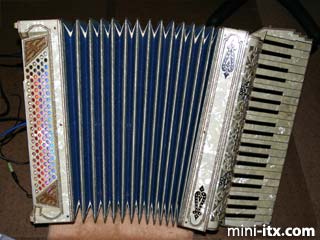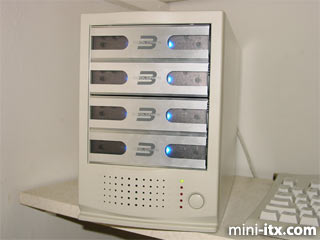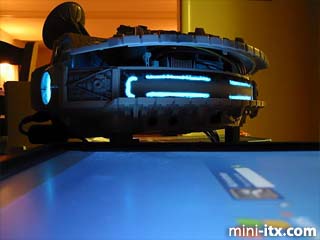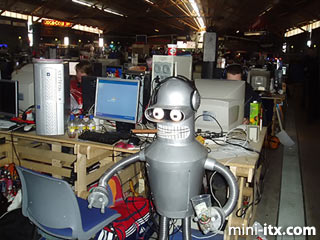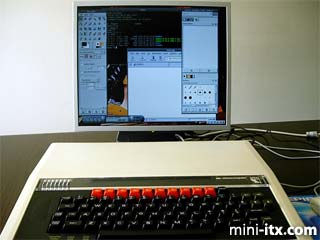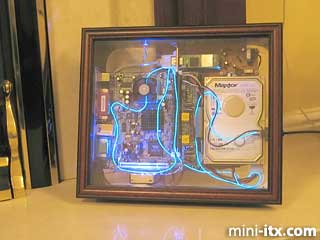Home | News Archive | May 2005
AMD's Geode LX Processor Chipset
May 31, 2005
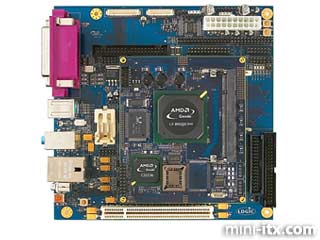
AMD plans to start production of its low power consumption Geode LX chipset later this year, providing a rival for VIA's forthcoming "Luke" CoreFusion chipset line.
The Geode LX800@0.9W CPU sits between the more robust 667 MHz to 1.2 GHz Geode NX chips announced a year ago, and the Geode GX and SCxxx chips inherited from National Semiconductor's "Geode" branch, acquired by AMD in 2003. AMD hope manufacturers will include the chip in their thin clients, set top boxes, HDTVs, kiosks and tablet PCs, to name but a few.
Power savings on previous designs have been found by reducing the process size from 0.15 to 0.13 microns, and through a power manager that shuts down unused parts of the CPU during operation. Performance is enhanced with 400Mhz memory bandwidth, an upgrade of the Level 1 data cache from 16 Kbits to 128 Kbits, and by adding a 128 Kbit Level 2 cache. Security features now include hardware based AES encryption/decryption and a 128 bit random number generator.
The LX800@0.9W variant actually has a clock speed of 500Mhz: AMD use a performance-power rating system that doesn't directly represent clock speed. The LX has been benchmarked as 50% faster than a previous Geode CPU, the 400Mhz GX533, which in turn was benchmarked by AMD as equivalent to a (presumably circa 2002) VIA C3 processor running at 533Mhz... The 0.9W figure reflects current draw at around 80% load, though this figure does not include supporting chips.
AMD have bundled everything into a convenient Mini-ITX form factor Geode LX DB800 Development Board, consisting of a CPU Module Board sitting on top of a 17cm x 17cm Base Board. Visible in our picture are both the LX800 CPU (which also integrates a 2D graphics controller), and the CS5536 South Bridge on interface duties.
VIA Announce C7 Processors
May 27, 2005
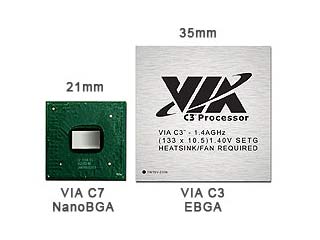
VIA has officially announced a new range of processors, based on their next generation x86 compatible "Esther" core.
The C7 will be manufactured for VIA by IBM in Fishkill, New York using a 90nm Silicon on Insulator process. According to Glenn Henry, the President of Centaur Technologies and chief architect of VIA's processor design strategy it is “the culmination of many years of designing for the optimal balance of mobility, performance, and security”.
Clock speeds are expected to reach up to 2Ghz, with power consumption varying between 0.1W at idle and 20 Watts peak on a 2Ghz chip, with bus speeds up to 800Mhz possible. The C7's tiny 30 mm square die includes technology to reduce processor speed when computing loads are light: at 1GHz, consumption is a maximum of 3 Watts, and at 1.6GHz it is 12 Watts. This bodes well for low temperatures - though the fastest variants may still require some active cooling.
The C7 also features VIA's Padlock security suite, a combination of a hardware random number generator and cryptography engine - already available on existing VIA processors - but adds more layers to the cake with SHA-1 and SHA-256 hashing for secure message digests, and a hardware based Montgomery Multiplier supporting key sizes up to 32K in length to accelerate public key cryptography, such as RSA.
Although we eventually expect to see the C7 on a Mini-ITX board, VIA's target market is far wider: they would like to see the C7 in thin and light notebooks, mini PCs, green clients, home media centers and PVRs, and high density server and server appliances. Mass production is expected to begin at the end of Q2 2005, with 1.5GHz and 1.8GHz C7 notebooks reaching the shelves in India and elsewhere within a couple of months.
Current Mini-ITX boards are powered by various iterations of the C3 processor. Regular readers may remember VIA's processor naming convention change a few months ago.
The "Accordion ITX"
May 25, 2005
Q) What's the difference between an onion and accordion?
A) People cry when they chop up onions.
Lennie Moore plainly marches to a similar beat, and has done the world a great service by elegantly squeezing his Mini-ITX motherboard into an old Enrico Bertini accordion. Having gotten a bit keyed up once or twice ourselves in the Paris metro, we can't help but be in accord with this decision.
The Accordion ITX (aka Enrico Music Server) was a concerted effort by Lennie and his friend Jim, whose forte, judging from the 4-disk RAID5 array used to run the server and the PHP server apps used to program it, lies between hardware and software. Cold cathodes are used to create a harmonious effect, with lights matching the volume of the wav and mp3 files played. Impressively, the server will start up when three particular keys are pressed simultaneously, presumably while wearing a tailcoat and only under dramatic circumstances. A major irony, when you consider that most people probably use three keys simultaneously to shut down their computers, and far less musically at that.
The Accordion ITX was constructed using an EPIA 5000, running SuSe 9.1 and using the Music Player Daemon from musicpd.org for playback. Now, the only thing we can't understand is why more people don't do this to bagpipes. And saxophones.
Lennie doesn't just make accordions that play mp3s. He recently composed music for Dragonshard, a real time strategy game due out from Atari next month. Clever chap!
Lennie Moore's "Accordion ITX"
OK. We take back what we said about Accordions. We just remembered The Arcade Fire use one...
Advertising with Mini-ITX.com
May 17, 2005
Banner ads are unfortunately a necessary evil in the world of web publishing. We'd like the ads we serve to be Mini-ITX friendly, so are issuing this reminder to potential advertisers that we have space on our pages available. We have two positions - the standard banner advert at the top of the page (currently inhabited by generic ads), and a prime position on the left for the more discerning advertiser (currently inhabited some of the time by the makers of this lovely case). If you have a product or website you want to promote to the Mini-ITX community, why not talk to us?
The "FileServerRouterSwitch"
May 16, 2005
Imagine...you're routing around in the closet and find a collection of computer components that are currently doing nothing useful. What to do? Well, you could switch on the TV, chug some port and leave springcleaning for another slot in the calendar, or you can create a hubbub by producing something like the FileServerRouterSwitch: a former SCSI disk case transformed into a multi-drive, multi-ported, Mini-ITX-based file serving whatchammuthingy.
Dennis Bakker's "FileServerRouterSwitch"
The "Mini Falcon"
May 15, 2005
Sean Wachob saw the Falcon-ITX and liked it so much he made is own, but this time using a smaller Millenium Falcon model. The result was the "Mini Falcon". We like it. Almost as much as we like this.
The "Bender PC"
May 13, 2005
Jan Erik Vangen volunteered his splendid homage to the lovable metal robot rogue from Futurama for the Mini-ITX project time capsule. Those crazy Norweigans.
Italian Oddities
May 12, 2005
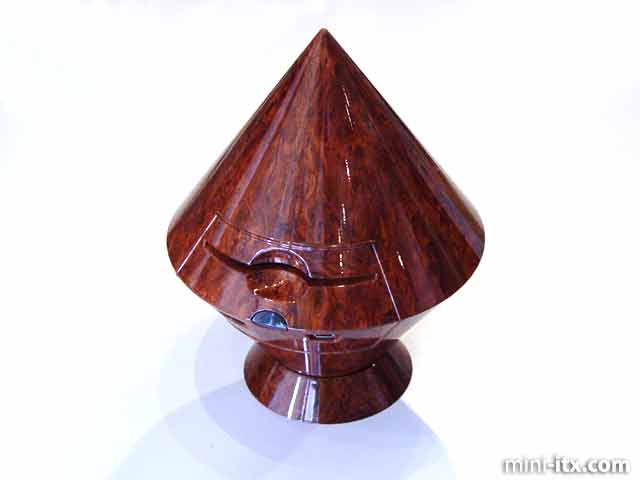
We chanced upon these Mini-ITX based oddities nestling in a shop window in Venice, Italy a couple of weeks ago. Unfortunately we promptly lost their business card while cavorting in a Traghetto, so we can only give you these intriguing pictures. Those crazy Italians.
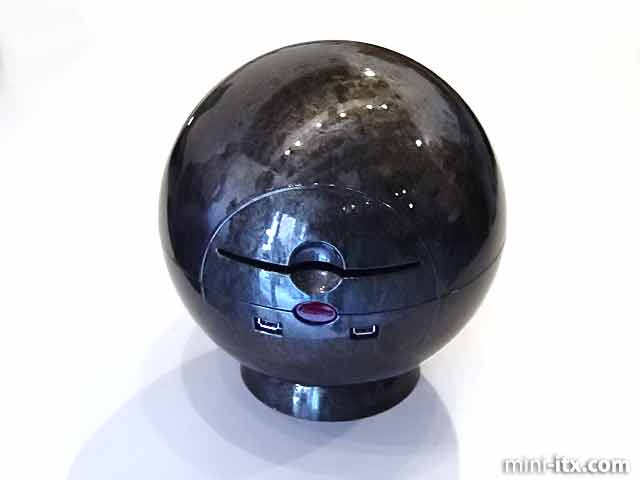
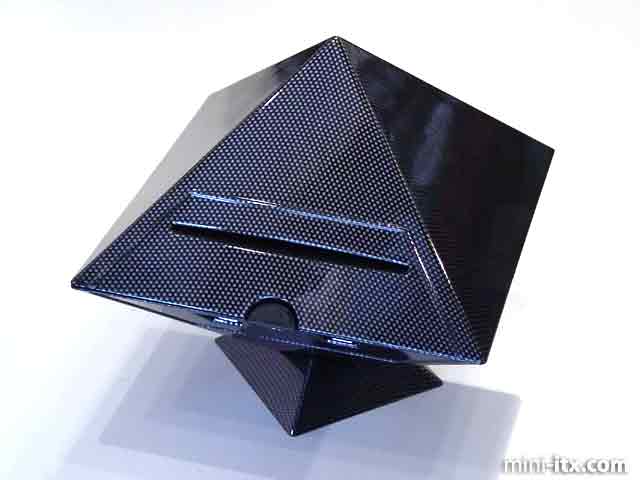
The "BBC ITX B"
May 11, 2005
Computer-loving Brits of a particular vintage (including us) will remember with affection the BBC Micro Model B... the rest of you probably won't know what on earth we're talking about.
The BBC Micro was introduced as a learning tool on the back of a documentary about the brave new world of micro-processing. What it actually introduced to many of us was a world of clandestine after-school gaming, huddled around a monitor waiting our turn to play Planetoid, Snapper or Chuckie Egg.
Graham Thompson certainly remembers it, and with outrageous disrespect for halcyon times past he has created a machine with 33,333% more MHz oomf than the original: the "BBC ITX B", powered by an EPIA ME 6000 motherboard.
This puppy runs Linux, and of course a trusty Beeb emulator. Graham went full-stealth, and rewired the original back panel, and even more cunningly made the original keyboard work as nature intended.
The "Frame"
May 10, 2005
Life can be hard for married computer enthusiasts (as certain Mini-ITX editors are surely about to learn).
Mark Pepper discovered that living under the crushing jackboot of female tyranny meant he wasn't allowed to let trailing wires, miscellaneous components, dusty beige boxes or whirring mechanicals spoil the tasteful haven of his family living area. Unbelievable... he probably doesn't even get respect for being able to balance a pint of beer on his nose or hit the ceiling when clipping his toenails. Fortunately, in a valiant counterattack for males the world over, Mark came up with a scheme to stash at least one PC into the living room. Meet the cunningly camouflaged "Frame" - a Mini-ITX project that qualifies as wall art.
 |
 |
 |
Quick Links
Mailing Lists:
Mini-ITX Store
Projects:
Show Random
Accordion-ITX
Aircraft Carrier
Ambulator 1
AMD Case
Ammo Box
Ammo Tux
AmmoLAN
amPC
Animal SNES
Atari 800 ITX
Attache Server
Aunt Hagar's Mini-ITX
Bantam PC
BBC ITX B
Bender PC
Biscuit Tin PC
Blue Plate
BlueBox
BMW PC
Borg Appliance
Briefcase PC
Bubbacomp
C1541 Disk Drive
C64 @ 933MHz
CardboardCube
CAUV 2008
CBM ITX-64
Coelacanth-PC
Cool Cube
Deco Box
Devilcat
DOS Head Unit
Dreamcast PC
E.T.PC
Eden VAX
EdenStation IPX
Encyclomedia
Falcon-ITX
Florian
Frame
FS-RouterSwitch
G4 Cube PC
GasCan PC
Gingerbread
Gramaphone-ITX-HD
GTA-PC
Guitar PC
Guitar Workstation
Gumball PC
Hirschmann
HTPC
HTPC2
Humidor 64
Humidor CL
Humidor II
Humidor M
Humidor PC
Humidor V
I.C.E. Unit
i64XBOX
i-EPIA
iGrill
ITX Helmet
ITX TV
ITX-Laptop
Jeannie
Jukebox ITX
KiSA 444
K'nex ITX
Leela PC
Lego 0933 PC
Legobox
Log Cabin PC
Lunchbox PC
Mac-ITX
Manga Doll
Mantle Radio
Mediabox
Mega-ITX
Micro TV
Mini Falcon
Mini Mesh Box
Mini-Cluster
Mobile-BlackBox
Moo Cow Moo
Mr OMNI
NAS4Free
NESPC
OpenELEC
Osh Kosh
Pet ITX
Pictureframe PC
Playstation 2 PC
Playstation PC
Project NFF
PSU PC
Quiet Cubid
R2D2PC
Racing The Light
RadioSphere
Restomod TV
Robotica 2003
Rundfunker
SaturnPC
S-CUBE
SEGA-ITX
SpaceCase
SpacePanel
Spartan Bluebird
Spider Case
Supra-Server
Teddybear
Telefunken 2003
TERA-ITX
The Clock
ToAsTOr
Tortoise Beetle
Tux Server
Underwood No.5
Waffle Iron PC
Windows XP Box
Wraith SE/30
XBMC-ION

